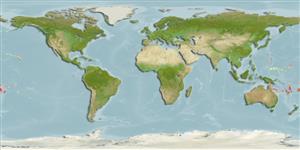>
Ovalentaria/misc (Various families in series Ovalentaria) >
Pomacentridae (Damselfishes) > Pomacentrinae
Etymology: Amblyglyphidodon: Greek, amblys = darkness + Greek, glyphis = carved + Greek, odous = teeth (Ref. 45335); melanopterus: Name from Greek 'melanos' for black and 'pteron' for fin; referring to the black caudal fin and soft portions of the dorsal and anal fins..
More on authors: Allen & Randall.
Environment: milieu / climate zone / depth range / distribution range
Ekologi
laut berasosiasi dengan karang; kisaran kedalaman 2 - 8 m (Ref. 82240). Tropical
Pacific Ocean: known only from Tonga.
Size / Weight / umur
Maturity: Lm ? range ? - ? cm
Max length : 10.2 cm SL jantan/; (Ref. 82240)
deskripsi pendek
Kunci identifiaksi (pengenalan) | Morfologi | Morfometrik
Duri punggung (Keseluruhan (total)) : 7 - 8; duri punggung lunak (Keseluruhan (total)) : 11 - 13; Duri dubur: 2; Sirip dubur lunak: 11 - 13; vertebrata, bertulang belakang: 26. This species is distinguished by the following characters: D XII-XIII (rarely XII),11-13; A II,11-13; pectoral rays 16-18; lateral line tubed scales 14-17 (modally 16); gill rakers 8-9 + 22-24 (total, 30-33, modally 31-32); body depth is 1.65-1.8 in SL; teeth are incisiform, in a single row; scaled suborbital; scales dorsally on snout extending well before nostrils, nearly to base of upper lip; colour of dorsal part of head, anterior body and scaled basal part of dorsal fin is light greyish green, scale edges are dusky, shading ventrally and posteriorly to greenish or pinkish white; naked portion of caudal fin and soft portions of dorsal and anal fins are black; pectoral fins with transparent membranes and faintly dusky rays; without black spot at base or axil of pectoral fins; pelvic fins are white (Ref. 82240).
Presumed to be reef-associated (Ref. 46206). Oviparous, distinct pairing during breeding (Ref. 205). Eggs are demersal and adhere to the substrate (Ref. 205). Males guard and aerate the eggs (Ref. 205).
Life cycle and mating behavior
Maturities | Reproduksi, perkembang biakan | Spawnings | Egg(s) | Fecundities | Larva
Oviparous, distinct pairing during breeding (Ref. 205). Eggs are demersal and adhere to the substrate (Ref. 205). Males guard and aerate the eggs (Ref. 205).
Allen, G.R. and J.E. Randall, 2002. A review of the leucogaster species complex of the Indo-Pacific pomacentrid genus Amblyglyphidodon, with descriptions of two new species. aqua, J. Ichthyol. Aquat. Biol. 5(4):139-152. (Ref. 82240)
Status IUCN Red List (Ref. 130435)
ancaman kepada manusia
Harmless
penggunaan manusia
Alat, peralatan
laporan khas
muat turun XML
Sumber internet
Estimates based on models
Preferred temperature (Ref.
123201): 24.9 - 29.2, mean 27.1 °C (based on 163 cells).
Phylogenetic diversity index (Ref.
82804): PD
50 = 0.5005 [Uniqueness, from 0.5 = low to 2.0 = high].
Bayesian length-weight: a=0.02344 (0.01149 - 0.04783), b=2.99 (2.82 - 3.16), in cm total length, based on LWR estimates for this (Sub)family-body shape (Ref.
93245).
Trophic level (Ref.
69278): 2.7 ±0.3 se; based on size and trophs of closest relatives
Daya lenting (Ref.
120179): Tinggi, Waktu penggandaan populasi minimum kurang dari 15 bulan (Preliminary K or Fecundity.).
Fishing Vulnerability (Ref.
59153): Low vulnerability (10 of 100).
Nutrients (Ref.
124155): Calcium = 123 [61, 196] mg/100g; Iron = 0.767 [0.454, 1.301] mg/100g; Protein = 18.2 [17.0, 19.3] %; Omega3 = 0.101 [0.058, 0.169] g/100g; Selenium = 17.8 [9.7, 34.9] μg/100g; VitaminA = 97.4 [26.9, 337.0] μg/100g; Zinc = 1.9 [1.3, 2.8] mg/100g (wet weight);
